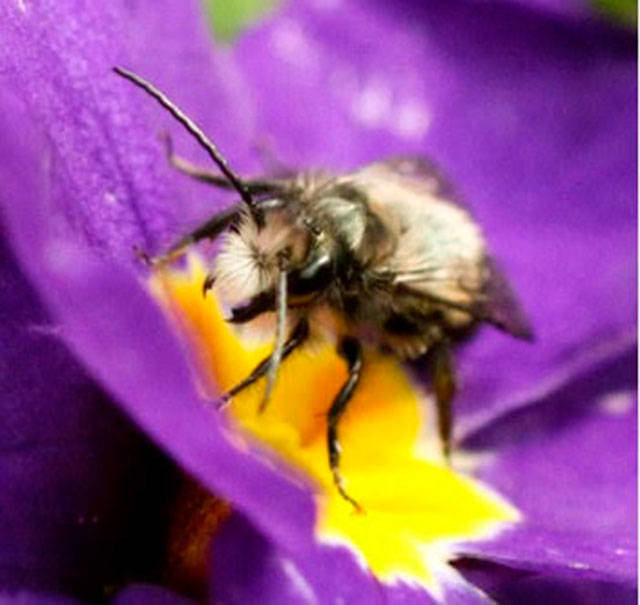Inviting mason bees to work and live in your garden or orchard is easy. While there are many kinds of pollinators, none is more efficient, gentle and easy to accommodate than mason bees.
Mason bees are well adapted to our western Washington climate and plant varieties. It is quite possible that you already have mason bees working in your garden, yet unnoticed.
Mason bees are not aggressive, do not make honey, and are purportedly seven times more efficient than honey bees when pollinating fruit trees.
Mason bees are black or bluish-black and two-thirds the size of honey bees. They can be mistaken for other species because their scopa, or body hair on legs, belly and brow, may be laden with golden pollen.
Mason bees, smia lignaria, are called solitary bees because they nest in preexisting tunnels or holes, not in hives. Avoid pesticides or other toxic spray on trees or nesting areas during the six weeks of spring that mason bees do their work.
When spring temperatures reach 50degrees and fruit blossoms are out, mason bees emerge from their nests. First the males, who are smaller than females, begin gather pollen to fortify them for mating. Three or four days later, females emerge for mating with multiple partners. While males live 10-15 days, females begin gathering pollen and nectar for the “next gen” of mason bees.
During the four to six weeks after hatching, each female will lay up to 35 eggs. Females gather pollen and nectar to mix into a “pollen ball,” which is placed in the back of the tunnel. Backing into the tunnel, the female will lay one egg, about 3mm long, on the pollen ball.
Next, the female will bring dirt and moisture back to the tunnel making mud to seal the egg chamber. This process is repeated until the tunnel is full.
Female eggs are laid in the back part of the tunnel, and males are in the front. The ratio is about one-third females to two-thirds males. When fruit is set and blossoms are gone, the females die.
Life in the tunnels continues. The eggs feast on pollen, develop into pupae, spin cocoons and transform into adults by September. Adult bees sleep in their cocoons throughout winter, until the temperature and blossoms are ready in spring. Cocoons can winter-over outdoors.
Mason bees range no further than the length of a football field. All needed elements should be nearby. Since they do not drill their own tunnels, they will need decaying wood with insect or bird holes, pre-made nest blocks, or clusters of straw-like tubes within range of fruit and berry blossoms.
Mason bees need water and soil to create “masonry” mud partitions between each egg in the nest tunnel. Openings for the tunnels at approximately 5/16-inch in diameter should have a southern exposure with a short roof shielding them from rain and heat. Avoid hanging nests on your fruit trees or locations with too much shade.
Mason bee cocoons are well known amongst predators for their delicious, nutritious feast of pollen and eggs. Birds, squirrels and wasps frequently raid the nests. Mesh screens can be secured over the front of the nests for extra protection.
Provide housing options to encourage existing mason bees to stay. Cleaning out old tunnels or purchasing new mason bee cocoons from local nurseries effective way to jump-start your pollinator population.
For more information about hosting mason bees, check out the Washington State University website: http://extension.wsu.edu/snohomish/garden/gardening-resources/bees-and-beekeeping/native-bees/.
Beverly Hetrick is a Clallam County Master Gardener.



